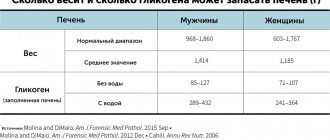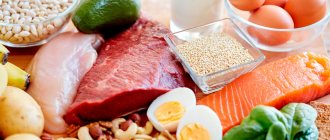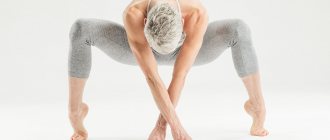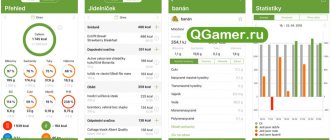Calorie is a unit of measurement of the energy value of foods. We are talking about the amount of thermal energy that the body produces when digesting food. Kilocalories (kcal) are traditionally used to denote it.
How do scientists calculate the energy value of certain foods? They burn them in special devices and measure the amount of heat that is released. Sealed chambers also make it possible to measure the heat generated by a person, which makes it possible to judge the physiological energy value of food.
There are different approaches to weight control. One of the most effective is to count calories. In short: to lose weight, you need to expend more energy than you consume. But how do you know for sure how many calories you take in per day and how many you “burn”? Calculation systems have been developed for this purpose. To calculate the calorie content of your diet, you need to know the weight of each portion and keep a food diary. If you're not used to it, it may seem difficult and burdensome, but you will quickly get used to it. Moreover, special applications for smartphones make the task easier.
Daily calorie intake for an adult
How many calories you need to consume per day depends on many factors, including age, weight, height, gender, health and lifestyle. Doctors have different estimates of the recommended caloric intake. The British National Health Service gives these figures:
- 2,500 kilocalories is the average norm for men per day;
- 2,000 kilocalories is the average norm for women.
There are a thousand calories in one kilocalorie. The numbers shown reflect the number of calories needed to maintain a stable body weight. You shouldn’t rely on these numbers if you’re planning to lose weight, but they are important to take into account in order to clearly understand your own physiological needs. However, there are other recommendations, for example, American researchers propose a different standard:
- 2,700 kcal per day – for men;
- 2,200 kcal – for women.
At the same time, the UN states that the average person needs a minimum of 1,800 kcal per day. Please note that this is the minimum, and not the optimal amount of calories according to UN experts. At the same time, the British National Health Service recommends paying attention not only to the calorie content of food, but also to its quality and variety, and not neglecting physical activity. Israeli scientists insist that a hearty breakfast of up to 700 kcal helps maintain a healthy body weight and reduces the risk of developing diabetes.
However, all these figures are approximate. And to calculate how many calories you personally need per day, you will have to use special formulas.
How many calories do you burn per day?
Women:
| Body weight (kg) | Sedentary lifestyle (kcal) | Moderate activity (kcal) | High activity (kcal) |
| 40 | 1430 | 1730 | 2040 |
| 50 | 1570 | 1900 | 2240 |
| 60 | 1700 | 2070 | 2440 |
| 70 | 1850 | 2240 | 2640 |
| 80 | 1990 | 2410 | 2840 |
| 90 | 2130 | 2580 | 3040 |
Men:
| Body weight (kg) | Passive lifestyle (kcal) | Moderate activity (kcal) | High activity (kcal) |
| 50 | 2000 | 2500 | 2950 |
| 60 | 2200 | 2680 | 3150 |
| 70 | 2340 | 2840 | 3350 |
| 80 | 2480 | 3000 | 3550 |
| 90 | 2620 | 3190 | 3750 |
| 100 | 2760 | 3360 | 3950 |
Calculation of calories for weight loss
To lose weight, you need to eat fewer calories than you burn. It is not difficult to understand exactly how many calories should be in your daily diet: you need to reduce the energy value of food. If you regularly train or play sports at least several times a week, it is enough to reduce the caloric content of your diet by 10%. That is, if you calculate that your physiological norm, taking into account your lifestyle, is 1800 calories, then to lose weight you need to reduce your daily diet to 1680 kcal.
If you lead a sedentary lifestyle and physical activity is an exception to the rule, you will have to subtract 20% of calories from the daily menu. Then, with a physiological norm of 1800 kcal, you will need to eat only 1440 kcal per day to lose weight.
A sharp reduction in diet of more than 20% poses health risks. But if you are obese and tend to overeat, your doctor may recommend reducing your diet by 40%. But not from the physiological norm, but from the number of calories that you are used to eating every day.
Harris-Benedict formula
The mathematical calculation of the daily calorie intake begins with determining the needs of the basal metabolic rate (BMR, basal metabolic rate) - the amount of energy required by the body to maintain vital functions.
- BMR or “resting energy” includes calories needed for brain function, maintaining body temperature, digesting food and other metabolic processes.
BMR calculation formula
- for men: BMR = 88.36 + (13.4 x weight in kg) + (4.8 x height in cm) - (5.7 x age in years) for women: BMR = 447.6 + (9. 2 x weight in kg) + (3.1 x height in cm) - (4.3 x age in years)
The average BMR is 1200 kcal. This is where the recommendation to lose weight by 1200 kcal came from - this is the amount of calories that will allow you to survive.
Between 20 and 50% of calories are spent by the body not on basal metabolism, but on daily movement. To determine the body's total caloric needs, you need to multiply the BMR corresponding to your gender, age and weight by the daily activity ratio.
Daily activity rate
It is in the activity coefficient that the main difficulty in calculating calories is hidden.
Let's say you calculated your basal metabolic rate and got an exact number, say 1,765 kcal. We need to multiply it by a coefficient that varies from 1.2 to 1.9. Now you need to understand exactly what coefficient to multiply BMR by, because the difference between the daily norm with coefficients of 1.2 and 1.9 is as much as 1,236 kcal (3,354 kcal - 2,118 kcal)!
The classic Harris-Benedict formula for calculating daily calorie intake offers only five coefficients:
| Minimum level of activity (no physical activity) | 1,2 |
| Low level of activity (exercise 1–3 times a week) | 1,375 |
| Moderate level of activity (exercise 3–5 times a week) | 1,55 |
| High level of activity (exercise 6–7 times a week) | 1,725 |
| Very high activity level (more than one workout daily) | 1,9 |
What factor should you multiply BMR by if you train three times a week? Should cleaning in the apartment be taken into account? Is yoga considered a physical activity? So many questions and so few answers.
It is precisely because of the uncertainty with the coefficient that fitness bracelets and scales with a fat analyzer will show only an approximate value - their error reaches 500 kcal.
Daily calorie intake
Let's not quibble and show you how to calculate your daily calorie intake using the Harris-Benedict formula.
- Man, 25 years old, 178 centimeters, 72 kilograms, plays sports three times a week, the rest of the days he works in the office:
BMR = 88.36 + (13.4 x 72) + (4.8 x 178) - (5.7 x 25) = 1,765 kcal
Calorie Value = BMR x Daily Activity Ratio = 1,765 x 1.55 = 2,735 kcal
- Woman, 25 years old, 172 centimeters, 50 kilograms, goes in for fitness four times a week, leads an active lifestyle and is on the move most of the day:
BMR = 447.6 + (9.2 x 50) + (3.1 x 172) – (4.3 x 25) = 1,333 kcal
Calorie Value = BMR x Daily Activity Ratio = 1,333 x 1.725 = 2,299 kcal
And one more thing: any calorie calculations that take into account weight will only be correct for people of average build. These formulas are not suitable for overly thin, overweight and muscular people.
A simple way to balance your diet for weight loss
Calculating calorie content requires habit and knowledge of the energy value of different foods. It is important not only to adhere to the daily norm, but also not to forget about the quality of the products. Because 500 kcal of fresh vegetables is healthier than 500 kcal of sweets and fast food. You don’t have to weigh the food yourself and create a menu for the week: we offer ready-made balanced meals for the amount of kcal you need. It is not only healthy, but also tasty, which means that there will be no temptation to indulge in foods that are too high in calories.
Balanced nutrition delivery Moscow | Delivery of ready-made food for a week reviews | Proper nutrition to the office delivery | Detox juices with delivery | Fish program at home | Complex for weight loss | Sports food at home | Prepared food for vegans
Contraindications
Despite all the advantages of a calorie diet, it is still not suitable for some categories of people. So, pregnant women should give up the idea of losing weight by counting calories. During lactation, it is also undesirable to strictly limit yourself in food. For chronic diseases, gastrointestinal diseases, hypertension and diabetes, choosing a weight correction program should only be done under the supervision of a specialist. And, naturally, such a marathon is contraindicated for teenagers and elderly people.
Before the event, be sure to consult your doctor!
Rating of food delivery for weight loss
Delivery of food with calculated calorie content, ready-made diets. No more cooking and counting calories!
Go
Go
Why and how to count calories, what is needed for this
To many, this technique may seem overly complicated, but this is only at first glance. Reasonable dietary restrictions will allow you to maintain the desired physical shape and make your diet more balanced. A competent approach to this issue will help you gradually adjust your eating habits. Counting calories allows you not to give up eating certain foods, but to make losing weight more comfortable.
If you eat fewer calories than your body can convert into energy, your body will use stored fat to restore energy. On the one hand, it seems that it is much easier to follow a strict diet in order to achieve the desired result as quickly as possible. But after quickly achieving results, there is a “rollback”: you want to loosen control and eat sweets or junk food. As a result, a person receives a short-term effect, but in the long term risks gaining weight again, and even more.
Calculation of daily calorie needs for women of different age categories
Women 18-30 years old (0.0621*weight in kg+2.0357)*240=kcal
Women 30-60 years old (0.0342*weight in kg+3.5377)*240=kcal
Women over 60 years old (0.0377*weight in kg+2.7545)*240=kcal
How to correctly calculate the KBZHU of products
In order to finally understand the issue of calorie counting, you need to understand how to count the KBJU of products (calories, proteins, fats and carbohydrates) and where to get all the information on the numbers of these products. Let's take a step-by-step look at how to correctly count calories, as well as proteins, carbohydrates and fats in foods. Read more about how much protein, carbohydrates and fats each person needs here: How to calculate BZHU (proteins, fats, carbohydrates) and what is it for?
Where can I find the calorie content and nutritional value of foods?
- See the product packaging for all information on calories, proteins, carbohydrates and fats. The most accurate information is provided there.
- If the product is sold without packaging or the energy value is not indicated on the packaging, then look up the calorie content and nutritional content on the Internet. Just, for example, enter “banana KBZHU” into a search engine and find all the necessary data. It is advisable to look at several sources to ensure the accuracy of the data.
- If you use a website or mobile application to count calories, they usually contain a ready-made database of products with KBJU data. Therefore, there is no need to search for additional information.
- If you have a complex dish that consists of several ingredients, then weigh each individual ingredient, calculate the KBJU for each ingredient separately and add up the resulting numbers. More on this below.
How to correctly calculate KBZHU: examples
Let's look at specific examples of how to correctly count calories, proteins, fats and carbohydrates for individual products and ready-made dishes.
1. Cottage cheese 5 % We look at the calorie content of the product on the packaging. If it’s not listed, then we’re looking on the Internet.
KBZHU cottage cheese 5% - 100 g:
- Calories: 121 kcal
- Proteins: 17 g
- Fat: 5 g
- Carbohydrates: 1.8 g
a) For example, you decide to eat 80 g of cottage cheese. In order to calculate the KBZHU of 80 g of cottage cheese, simply multiply each indicator by 0.8:
KBZHU cottage cheese 5% - 80 g:
- Calories: 121 * 0.8 = 96.8 kcal
- Proteins: 17 * 0.8 = 13.6 g
- Fat: 5 * 0.8 = 4 g
- Carbohydrates: 1.8 g * 0.8 = 1.44 g
b) If you decide to eat 225 g of cottage cheese, then multiply each indicator by 2.25:
KBZHU cottage cheese 5% – 225 g:
- Calories: 121 * 2.25 = 272.3 kcal
- Proteins: 17 * 2.25 = 38.25 g
- Fat: 5 * 2.25 = 11.25 g
- Carbohydrates: 1.8 g * 2.25 = 4.05 g
Thus, we obtain specific KBZHU of cottage cheese depending on its weight.
2. Oatmeal . This is the most popular breakfast among those who try to follow a healthy diet. Counting calories for oatmeal is also very simple. By analogy with the plan proposed below, we calculate the KBJU for all other cereals and pasta.
a) Weigh the oatmeal in dry form (precisely dry, this is important!). For example, you got 70 g. Let’s look at the KBZHU data on the packaging or on the Internet for 100 g:
KBJU oatmeal – 100 g:
- Calories: 342 kcal
- Proteins: 12 g
- Fat: 6 g
- Carbohydrates: 60 g
Since we do not plan to eat 100 g, we calculate 70 g per serving, multiplying all indicators by 0.7:
KBJU oatmeal – 70 g:
- Calories: 342 * 0.7 = 240 kcal
- Proteins: 12 * 0.7 = 8.4 g
- Fat: 6 * 0.7 = 4.2 g
- Carbohydrates: 60 * 0.7 = 42 g
This is the final KBZHU of empty oatmeal per 70 g: K-240; B-8.4; Zh-4.2; U-42. No matter how much water you add, how much your porridge boils, and no matter how much it weighs after cooking, you enter data into your food diary based on dry matter . We do the same with other cereals, pasta, and potatoes.
On the Internet you can find calories for oatmeal already prepared. But it’s better not to rely on these numbers. The cereal absorbs water and swells, and its final weight may vary depending on how much water you add and how long the porridge is cooked. Therefore, always weigh all cereals only in dry (uncooked) form.
b) Suppose you are preparing oatmeal in milk with the addition of butter, honey and milk. In this case, we weigh each individual ingredient before cooking (cereals, butter, honey, milk), calculate the KBJU for each individual ingredient, sum it up and get the KBJU of the finished dish. We calculate all this before cooking! More details about the specific calculation of ready-made dishes are below.
3. Chicken breast . Another popular product among those losing weight, so let's look at it too.
We weigh the chicken breast raw, preferably after you have defrosted and dried it, so that excess moisture does not get into the calculations (well, this is if you remain completely accurate). For example, let’s calculate the KBJU of chicken breast per 120 g:
KBZHU chicken breast – 100 g:
- Calories: 113 kcal
- Proteins: 24 g
- Fat: 2 g
- Carbohydrates: 0.4 g
KBJU chicken breast – 120 g:
- Calories: 113 * 1.2 = 135.6 kcal
- Proteins: 24 * 1.2 = 28.8 g
- Fat: 2 * 1.2 = 2.4 g
- Carbohydrates: 0.4 g * 1.2 = 0.48 g
After we boil the chicken breast, we do not weigh it and do not count calories. We take into account data only in raw form. Spices and salt do not affect calorie content, but if you cook with oil, do not forget to add it.
How to count ready-made recipes
As we said earlier, when preparing complex dishes, we count calories as follows:
- Weigh each ingredient in wet/dry form
- We calculate KBJU for each ingredient according to the scheme above
- We sum up the data and get the total calorie content of the dish.
Let's give an example with a complex dish that we mentioned above: oatmeal with milk, honey and butter.
Ingredients for porridge:
- 130 g oatmeal
- 50 ml milk 3.2%
- 30 g honey
- 10 g butter
We calculate by analogy with the examples above, multiplying the data by the weight of the product. Then add up calories, protein, carbohydrates and fat.
| Cereals 130 g | Milk 50 ml | Honey 30 g | Oil 10 g | Total | |
| Calories | 444,6 | 29,5 | 98,7 | 74,8 | 647,6 |
| Squirrels | 15,99 | 1,45 | 0,24 | 0,05 | 17,73 |
| Fats | 7,93 | 1,6 | 0 | 8,25 | 17,78 |
| Carbohydrates | 77,35 | 2,35 | 24,45 | 0,08 | 104,23 |
We get the KBJU of oatmeal: K-647.6; B-17.73; F-17.78; U-104.23.
A simple way to calculate the KBJU of a finished dish
There is the simplest and most convenient way to calculate the KBJU of a finished dish. To do this, we will use the Calorizator website. Go to the Recipe Analyzer page and enter all our ingredients in the window that opens, separated by commas: 130 g oatmeal, 50 ml milk 3.2%, 30 g honey, 10 g butter:
Click analyze and instead of manually counting calories, we get ready-made numbers:
We look at the Total and get the finished calorie content of a complex dish with several ingredients.
Moreover, it is not necessary to enter the weight in grams; you can use the notation as follows:
As you can see, you can copy the finished recipe and calculate KBJU in this way. But be careful! For example, 2 onions in the understanding of the recipe analyzer is 150 g. But in reality it can be either 100 g or 200 g, depending on the specific size of the onion. The values in such programs are taken as average. Therefore, it is better to weigh and enter products into the analyzer in grams, having first weighed them.
If you use mobile applications to count calories, in the same way, it is better to weigh it rather than use “1 banana” or “1 onion” from a ready-made food base in your calculations.
I don't want to count calories!
And you don’t have to count them! The nutritionist calculates the calorie content and composition of the diet (proteins-fats-carbohydrates) and translates all this into grams of food or any other easily understandable reference points (portion sizes in spoons, glasses, cups, etc.). Of course, when you are given recommendations in grams and you weigh your food for several days, this is the most effective option for correctly changing body composition, quickly leading to the desired result - minus 4 kg of fat per month (and we have already discussed that these are very real and safe numbers and goals). After several days of weighing food, you yourself will “by eye” begin to understand how much salad, meat or porridge you should eat!
There are simplified techniques that help you choose the size of food, focusing on visual cues - “the size of a fist,” “half a plate,” “like a golf ball,” and so on. Today we will tell you nutrition SECRETS for those who don’t want to count calories and bother!
Important points for a calorie diet
Since the calculations are quite complex, it is recommended to prepare a menu for the week in advance. One of the most important points is five meals a day with calories calculated in the following ratio: breakfast - twenty-five percent, second breakfast - ten percent, lunch - within thirty percent, afternoon snack - up to twenty-five percent, dinner - ten percent.
To ensure that the body does not suffer from the lack of vital substances, it is necessary to include five food groups in the diet:
- polyunsaturated fats;
- fruits;
- cereals;
- proteins;
- vegetables.
Approximate diet menu by calories
According to the advanced Swedish nutritionist M. Ingmar, you need to consume more fat, in the ratio of thirty to forty percent of the total diet. With this distribution, the feeling of fullness will come faster and longer, and the stomach will not stretch.
Let's look at several different sample menus (you can adjust them yourself depending on the caloric content of the products and your well-being). The table shows an approximate list of products, which can be changed after agreement with the doctor.
| Breakfast | Oatmeal in water with two teaspoons of butter, one green apple |
| Lunch | Fifty grams of hard cheese (lactose-free), one medium-sized pear |
| Dinner | Boiled lean poultry meat, two hundred to three hundred grams of stewed vegetables |
| Afternoon snack | Milk or protein shake |
| Dinner | One hundred and fifty grams of salmon, one hundred and fifty grams of green vegetables |
How to burn 1 kg of fat with physical training?
The following approximate values were calculated for women with a height of 160 cm and a weight of 72 kg. However, it should be remembered that the number of calories burned depends not only on your parameters, but also on age, health, habitual physical activity and quality of nutrition. Therefore the following data are approximate only. So, how long does it take to burn 1 kg of fat?
- Running - 10 hours
- Jumping rope - 14 hours
- Swimming - 16 hours
- Roller skating - 16.5 hours
- Fitness classes - 18 hours
- Aqua aerobics – 22 hours
- Dancing - 24 hours
Recipes
In order for the diet to turn into a means to achieve a goal, and not into hard labor, we advise you to prepare delicious dishes that are not harmful to your figure. The menus above contain many different dishes, some of which you may not know how to prepare. Our recipes will come in handy.
Frittata with vegetables
You will need:
- chicken eggs – 3 pcs.;
- bell pepper – 1 pc.;
- onions – 1/2 pcs.;
- broccoli – 100 g;
- water – 5 tbsp. l.;
- olive oil – 2 tbsp. l.;
- spices - to taste.
Preparation:
- Chop broccoli, peppers and onions not very finely.
- Place in hot oil, add water and simmer for 10 minutes.
- Add spices, mix and remove from heat.
- Beat the eggs, not forgetting to add salt and pepper.
- Place the vegetables in a baking dish.
- Fill with egg mixture.
- Bake at 180 degrees for a quarter of an hour.
Cottage cheese casserole
You will need:
- low-fat cottage cheese – 450 g;
- egg – 2 pcs.;
- dried apricots – 2-3 pcs.;
- raisins – 10-15 pcs.
Preparation:
- Wash dried fruits. Fill with hot water for 5 minutes. Dry and cut.
- Combine cottage cheese with eggs and mix well.
- Add chopped dried fruits.
- Place the mixture in a silicone mold. Bake for about 40 minutes at 200 degrees.
Attention: before serving, the casserole must cool slightly; it is better not to remove it from the pan until this time.
Baked pollock
You will need:
- pollock – 2 small carcasses;
- lemon – 1/2 pcs.;
- olive oil – 2 tbsp. l.;
- dried rosemary – 5 g;
- salt, pepper, spices for fish - to taste;
- greens - for serving.
Preparation:
- We clean the fish, remove the fins, tail and entrails. Rinse under running cold water.
- Rub the carcasses with spices and sprinkle with rosemary.
- Drizzle with olive oil and lemon juice. Make sure that the pollock is well marinated on all sides.
- Place the fish on foil and wrap it up. Place in an oven preheated to 150 degrees for a quarter of an hour. Before serving, sprinkle with herbs.
Stewed spinach
You will need:
- spinach – 0.5 kg;
- leeks – 2 pcs.;
- parsley – 1/2 bunch;
- olive oil – 3.5 tbsp. l.;
- water – 80 ml;
- Provençal herbs, garlic, salt - to taste.
Preparation:
- Wash the greens. Let's dry.
- Cut the onion into thin rings.
- Finely chop the parsley.
- Heat the oil in a saucepan. Put onions in it. Stirring constantly, fry for 3 minutes.
- Now we add spinach leaves to the onion. Pour in warm water. Cover with a lid. Simmer for 3-4 minutes, stirring occasionally.
- Add chopped herbs, chopped garlic (if desired), spices. Cook for a couple more minutes, mixing all ingredients well. After the specified time, the dish is ready.
Broccoli soup
You will need:
- broccoli – 150 g;
- low-fat cheese – 30 g;
- skim milk – 150 ml;
- chicken broth – 250 ml;
- corn starch – 2 tsp;
- onions – 1/4 pcs.;
- carrots – 1/2 pcs.
Preparation:
- We clean the onion. We chop it up. Sauté in a saucepan or saucepan.
- Pour in the liquid ingredients. Cook for 5 minutes.
- We dilute the starch in a small amount of water so that lumps do not appear.
- Carefully pour the starch water into the milk-broth mixture, stirring constantly.
- When the broth begins to thicken, add grated carrots and broccoli. Mix.
- After cooking the vegetables, add grated cheese to the soup, remove the pan from the stove, stir for another 5 minutes, and then pour into plates.
Caesar with seafood
You will need:
- shrimp – 0.5 kg;
- grated parmesan – 1 tbsp. l.;
- crackers – 1/2 cup;
- lettuce - 1/2 bunch.
For the sauce:
- dietary mayonnaise (it is better to prepare it yourself) – 1 tbsp. l.;
- water – 1 tbsp. l.;
- parmesan – 1 tsp;
- black pepper - on the tip of a knife;
- garlic – 1 clove.
Preparation:
- Boil the shrimp in boiling salted water (just a couple of minutes). Place in a colander.
- Pour water into mayonnaise and mix.
- Add pepper, finely chopped garlic and Parmesan. Mix. The sauce is ready.
- In a salad bowl, mix peeled shrimp and croutons and place it all on lettuce leaves (they must first be torn by hand).
- Pour over the sauce and sprinkle with grated cheese.











